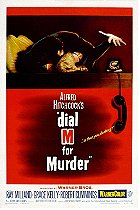
Posted : 14 years, 9 months ago on 21 August 2010 09:12
(A review of
Dial M for Murder)
Don’t ever let anyone tell you that Dial M for Murder is “minor” Hitchcock. Released during the height of his most fertile period, and in the same year as the indomitable Rear Window, Dial M for Murder is only “minor” when placed next to that canonized classic. On its own merits, it lays the groundwork for the self-reflexive works to follow, the aforementioned Rear Window along with Vertigo and Marnie come to mind, in how it explores its auteur’s particular obsessions and strong sense of control.
While Vertigo and Marnie would go into graphic detail in the ways that men control women, the creation of star personas, with a character as a proxy for the exacting director, Dial M for Murder openly embraces these elements. It doesn’t go into as deep and dark places, but it embraces a sense of artifice and theatricality, giving the distinct impression that these characters are mere puppets at play by a guiding hand. That guiding hand here is Tony (Ray Milland, perfectly detailing one of Hitchcock’s charming sociopaths), the husband of Margot (Grace Kelly), who wants to kill his wife off out of revenge for cuckolding him and to gain her wealth.
Tony decides that a former schoolmate, Charles (Anthony Dawson), will be the best person to use to enact his murder plan. The scene where he sits in his chair and details his motives, making the case for Charles to take the job is chilling for how casual Milland plays it. It also gives the vague impression of a director talking motivation and going over the script with his lead actor. This impression hardens as the scene goes on, when Tony begins blocking out the evening piece-by-piece for Charles, telling him the signals, locations, and alibis to use. It plays out less like a proposition and more like a dress rehearsal, and made even more chilling for the flippancy both men bring to the material.
When Tony’s plan goes awry, he turns it around into another opportunity, this time around to frame his wife. Tony transforms her from intended victim into unknowing pawn by framing her for the murder of Charles. It is here that Tony, Milland slowly revealing the man, as being composed entirely of toxicity and oil, fully becomes the Hitchcock-proxy. The director’s love of blonde, remote screen goddess slowly being broken down is well known, and by trying to destroy his wife, Tony fulfills Hitchcock’s near fetishistic obsession with this subject.
Let’s talk about that remote screen goddess, Grace Kelly. A gorgeous and impossibly stylish movie star supreme, Kelly was also something a lightweight actress, completely vacuous and out of her depth in any film that wasn’t a Hitchcock thriller of romantic comedy. But Hitchcock and Kelly is pure movie magic, a pairing of actress and director that ranks among the greatest like Josef von Sternberg and Marlene Dietrich. Not only does her get her to emote effectively, but he unlocked the duality of her true star charisma, a barely concealed flame in a glacier.
For me, this has long been her finest hour as an actress. She successfully frumps it up during the final act, writhes in sexual agony during her attack scene, finds the subtle moments of humor, and manages to wrap her ice-queen exterior around a core that resembles warmth and carnality. Even better is the blank-faced trial scene, where she slightly moves her head and gets bathed in increasingly darker shades of red. Her eyes go wide, panic slowly breaking across her delicate features before the screen is washed out in violent reds and purples consuming the screen. Kelly was the chilliest of his blondes, and a clear artistic simpatico shimmers throughout the three films they made together.
Then there’s just how sturdily built as a claustrophobic thriller Dial M for Murder is. John Williams is a hoot as the Scotland Yard inspector assigned to the case. The case never quite sits easily with him, and he manages to act bumbling while Milland inadvertently shows all his cards. It’s a treat to watch the give and take between the two men as one thinks he’s several steps ahead, and the other knows he’s an entire flight up patiently waiting for his traps to fall into place. Much of the tension in the second half comes from the escalation of the framing dissolving, while throughout the entire film it appears that the characters are trapped in the apartment as though it were a hell of their own making. The scene where Grace Kelly gets attacked is enough to recommend this, but there’s so much great technique and wonderful acting on display here that the film deserves a more exalted place in Hitchcock’s oeuvre.

0 comments,
Reply to this entry
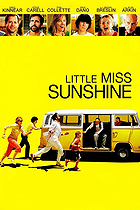
Posted : 14 years, 9 months ago on 21 August 2010 09:12
(A review of
Little Miss Sunshine)
Little Miss Sunshine contains a scene that speaks to the elusive truth that this film so hilariously points out to us again and again: we often see our destination without paying attention to the journey to get there. The scene in question? Towards the very end of an exhaustive (but laugh-filled) journey to get young Olive to the titular pageant, the family spots the hotel venue but can’t seem to navigate California’s complicated highway system to get the correct exit and arrive in time before check-in closes. What they finally decide to do is most amusing, and I will not spoil it here.
Little Miss Sunshine is a dysfunctional family road movie, but it accomplishes its goals with more heart, wit and fully-realized characters and performances than others in the genre. Dysfunctional families are a dime a dozen in novels, films and plays. But when they are done well, they are a mirror reflection of our times, values and us. I believe that such is the case with the family we are presented with here.
Fragmented yet strong, abrasive yet considerate, this is the disconnected but somehow still connected modern American family. A father whose failures as a self-help guru infects and sows the seeds of body-image and self-esteem issues in his young daughter is chastised and blocked out by the heroin-snorting, cranky grandfather who for all his faults loves his granddaughter. This scene occurs during the earliest part of the road trip in the film and is a small fragment, a brief example of a fantastically well-acted and well-written ensemble of actors giving life to a sharp, smart and emotionally rich script.
I remember during the 2006 Oscar season that Eddie Murphy was the frontrunner for the Best Supporting Actor race. I found his performance in Dreamgirls to be a warmed over James Brown impression from his stint on SNL. But Alan Arkin, bitter and loving in equal doses and exercising acerbic comedic muscles with razor-sharp timing, to be the only logical choice for the award and I prayed for an upset. He won, and every so often the underdog, in hindsight, looks like the better choice. Abigail Breslin, who is slowly growing up into an actress of tremendous warmth and likeability, was justifiably nominated for her performance here. The only real injustice is that Greg Kinnear, Toni Collette, Steve Carell and Paul Dano, able to bring down the house with just a twist of his neck, didn’t even get a breath in during the season. (Only a SAG Best Ensemble win amongst the main awards in the season.)
I find Little Miss Sunshine to still be utterly charming, and able to walk that fine line between uproarious comedic moments and painfully real moments. It remains for me, possibly, the best little-movie-that-could of the past decade.

0 comments,
Reply to this entry

Posted : 14 years, 9 months ago on 14 August 2010 03:39
(A review of
Maya)
MAYA is M.I.A.’s most divisive and schizophrenic album, which is really saying something after the Third World underground boogie that was Kala. At times it’s a dingy punk/noise rock dirge which wouldn’t have sounded out of place in Suicide’s 70s output (makes perfect sense that she sampled them), and at others a celebration of tacky-but-ever-so-catchy Bollywood-like rhythms. MAYA, while wildly inconsistent, is the work of a singular artist who is never anything less than intriguing. (To put it very, very mildly.)
M.I.A. obviously grew up with an ear for both grunge rock and old school rap like NWA and Public Enemy, because, at several points throughout the record, she combines these two disparate elements to form something truly remarkable. Lead off sonic-stomp of a single, “Born Free,” takes Suicide’s “Ghost Rider” and adds an entire arsenal of power-tools and noises to make something truly cacophonic and indescribably boogie ready. “Meds and Feds” is an aggressively industrial track. Unlike most industrial rock which created a melody line and then distorted into something frightening or indescribably inhuman, “Meds and Feds” sounds like she walked into construction zones, war zones, factories and anywhere else where the noise level was at a ridiculously high volume to record what she heard and rapped over it. I mean that as a compliment.
But every so often, it’s an inconsistent affair – remember?, she creates a, you know, real song. Or cover’s one, as is the case with the raga-like “It Takes a Muscle.” If songs like “Space,” “Lovalot” and “Tell Me Why” prove anything, it’s this – on her next go around, and maybe she should stick with trying to craft real songs because she’s amazingly gifted at it. All of that noise really isn’t necessary, even if it can be dizzyingly wonderful or unsettling and disturbing.
But we must discuss her lyrics for a minute. I have always admired her penchant for expressing her political view points, for giving a been-there/done-that view of refugee suffering, cultural unrest and terrorist backgrounds. But on this album more than any other, she sounds willfully murky and muddy. What is she trying to express specifically? Is all of that noise distracting me from her voice, or is she really that lost in the mix at times? The artist’s role isn’t to explain their work, but I might need her help with this one. She has always been a master of agitprop, but this blurs that line mightily. Could it be that she’s finally addressing and embracing her inherent contradictions? She’s been a refugee, but now she’s married into a cushy lifestyle. She refuses to let go of where she’s been or where she’s going which makes for exciting work. Now, if only her ego would stop getting in the way so damn much. Buried somewhere deep within MAYA is a five-star EP. DOWNLOAD: “It Takes a Muscle”

0 comments,
Reply to this entry
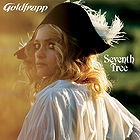
Posted : 14 years, 9 months ago on 14 August 2010 03:36
(A review of
Seventh Tree)
Oh Alison Goldfrapp, how do I love you? You debuted with something that could only be described as Weimar-era orchestral indie-electro-pop, then you went on to swallow up influences like Roxy Music, David Bowie and Blondie to unleash disco-glam rock ready burners like “Train” and “Ooh La La.” All the while you reinvented your look and sound with the kind of élan only seen in Madonna or, the icon of icons, Debbie Harry. Seventh Tree adds shades of pastoral concept album-era Kinks and Magical Mystery Tour to your indie-electronica pop. Supernature is still my favorite album, but this is a close second. Equally lush and inventive, an album of mostly ballads that doesn’t put me to sleep or sound likes the soundtrack to some kind of hipster dinner-party. It also includes a few of their best songs.
Album opener “Clowns” is a strong contender for their best ever ballad. Vocally she is unintelligible, but emotionally she is right on target. What is the song about? I’m not entirely sure. Perhaps about being true to yourself and going against that is to make you look and act like a clown? That is the emotion I get from the song. Equally lush are “Little Birds” which expands her Kate Bush fetish with touches of “Strawberry Fields Forever,” first single “A&E” for which the word hypnotic is not descriptive enough for, “Cologne Cerrone Houdini” in which she does her best Marlene Dietrich impression since the Felt Mountain cover (or is she trying to be Nico?) and “Happiness” which is as close to the electro bump & grind we’ve come to expect on this album.
But what is the best song on the entire album? The upbeat disco-meets-folk pop of “Caravan Girl.” What kind of pop music is this exactly? I’m not entirely sure. I hear strands of the Kinks’ Village Green Preservation Society, the Beatles’ “Penny Lane” and the bewitching vocals and chirpy synths of ABBA. If this song alone doesn’t qualify Goldfrapp for some kind of weird art-dance-rock, I don’t know what else will.
Goldfrapp have released four albums, each with a different sound and character. How many bands are currently doing that so steadily? Many artists promise true change and a new sonic landscape to get lost in, but deliver these promises only with the first single and release something awfully similar to their previous albums. Goldfrapp don’t want to drag you down into an underground S&M club anymore. They want to dress in soft, flowy outfits and frolic quietly in a watercolor field of grass and flowers. I loved joining them. DOWNLOAD: “Caravan Girl”

0 comments,
Reply to this entry
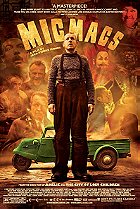
Posted : 14 years, 10 months ago on 25 July 2010 08:13
(A review of
Micmacs)
Micmacs is a film that drunkenly sways towards the edge. It never falls off, but it comes awfully close several times. As a biting satire of the arms race, it is just that. As a quirky film about quirky characters doing quirky things, it does its job. As an enjoyable film filled with whimsy and visual invention it’s quite good. It’s just too much of too many things. Almost too whimsical, almost too many ideas bouncing around all at once, too many quirky characters doing quirky things just because it’s French, and that’s what they do. But I was never bored, and I walked out enjoying it way more than the problems that I had with it.
The story, which seems secondary to the whimsy, is about a sad, lonely man who gets shot in the head and discovers two rival arms dealer’s right across the street from each other. The bullet is from one, and the bomb that killed his father in the opening sequence is from the other. He moves in with a group of carnival-ready oddballs in a cave hollowed out from a junkyard and plots his revenge. I’d like to pretend that this film centers the story first and has the weirdness as a logical outgrowth from it, but it doesn’t. I’m all for bonkers filmmakers and films that feature gorgeous visuals, but while, say, The Fall or Pan’s Labyrinth accomplish these goals, they’re also story-centered affairs. Micmacs could have done away with one or two eccentricities and been all the better for it, I nominate the love story which is never fully realized nor believable since it just happens.
Each of the actors must have been told to keep all of their emotions at an eleven on a scale of one to ten. Except for Dany Boon, our main character, who is trying for something resembling Buster Keaton’s great stone face and Charlie Chaplin’s beloved little tramp, think of his character as their progeny. He comes to closest to making us really care about these characters, but I never really invested in them the way I invested in Amelie. Again, they’re often struck down by weirdness for weirdnesses sake. It’s entertaining all right, but a bit too much.
It tackles a big message, the have-nots can topple the haves very easily, but it strains for charm. Amelie burst forth with charm and quirks, but it anchored itself on a solid story and a great performance. Micmacs is a film that I am glad that I have seen, but frustrated that it didn’t impress me as much. I am grateful that someone dared to be different and have this much visual invention, but knowing when and how to edit is key.

0 comments,
Reply to this entry
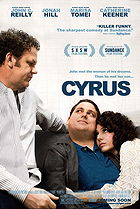
Posted : 14 years, 10 months ago on 25 July 2010 08:12
(A review of
Cyrus)
Cyrus had the incredible potential to be so much more than what it ended up being. With the absolutely fantastic cast that it has assembled and the premise that seemed like fertile ground for awkward and black comedy, Cyrus seemed destined to be an indie darling. Instead it winds up being another addition to the aggravating mumblecore movement. It does make one vast improvement over other mumblecore films: the characters feel like real people and not annoyingly damaged overbearingly quirky movie characters. Look, I’ve known my fair share of Greenberg’s and Margot’s, but these characters and films are so poorly written that it makes me want to inflict self-harm to make it all go away.
Cyrus teeters towards the edge of that precipice, but never fully falls into it. I place that saving grace squarely on the shoulders of the cast. A collection of Academy Award nominees (one of whom is a winner) and John Hill, in a performance of surprisingly intense and disturbed sociopathic tendencies that it makes you wonder if he was just slumming it in Superbad and Knocked Up. When presented with the vaguest of character outlines, the cast makes them feel real by improving and trying their best to make these people feel lived in and complicated.
For that reason alone Marisa Tomei deserves another award of some kind. When presented with what amounts to a stick figure, Tomei forges ahead and creates a portrait of a woman who has no one but her son. She is not dumb, but impossibly naïve about her son. Perhaps she has been fed too much fast-food self-help, you know the kind – it became the de jour thing in the 90s and hasn’t quite gone away since. One too many self-help books might do something like this to you. Look at Rielle Hunter. She can talk about her feelings and emotions with the broadest of therapeutic words, but can’t see that her son has intentionally damaged or destroyed every relationship (or possible relationship) she has ever had. Catherine Keener gives a great turn in a small supporting role as John C. Reilly’s ex-wife who wants him to get on with his life since their divorce was seven years ago. She seems almost too smart for him in many ways, and it’s a testament to her character that she was able to put up with him for that long and still remain good friends.
And John C. Reilly, surely, easily, one of my favorite actors currently working, has officially won back all of my love and admiration after detouring into cringe-inducing comedies well below his talents. He can portray hapless and slightly dumbfounded better than anyone. It’s a solid performance, nothing that he hasn’t done a variation of, or bettered in previous work. But it’s nice to seem him playing a character and not a schtick again.
Cyrus is fairly routine. It came armed with a trailer that screamed hilariously twisted comedy and delivered all of the funny in the trailer. Everything else is painfully awkward, predictable but very well-acted. This cast deserved so much better. I’m still waiting to be impressed by this mumblecore movement.

0 comments,
Reply to this entry

Posted : 14 years, 10 months ago on 25 July 2010 08:12
(A review of
The Hurt Locker)
Skirting pro and anti-war propaganda for as close to you-are-there verisimilitude as Hollywood can aspire to bring forth without actually making a documentary, The Hurt Locker is a tense, smart and insightful characterization of a particular kind of psyche. In times of war there are adrenaline junkies, those who require the structure and hierarchy, the off-chance that they could go out in the field and not return alive. The Hurt Locker examines these things, and presents action scenes which are outgrowths of the story and propel the actions and characters forward. They are not glib trailer-friendly but unnecessary shit-goes-boom-real-pretty scenes. It does this through a combination of visual stylization and you-are-there shaky cam work. It also comes complete with three lead performances of such strength and commanding presence that an injustice was committed in not mentioning Brian Geraghty and Anthony Mackie in the supporting actor race.
The Hurt Locker opens with a scene that perfectly encapsulates the tense action-drama that is about to unfold before us, it is a (roughly) ten minute study in maintaining a nerve-racking tone. In one of three incredibly brief cameo performances, Guy Pearce appears as our first bomb disposal technician. We learn about their friendship and work ethic by how they interact with each other. Each actor wears a particular gait and their body tells just as much of a story as the words coming out of their mouths. When it ends there is a cacophony of sounds and visuals. The rust flying off of a car, the disturbingly beautiful cloud of debris that will quickly engulf Pearce, the way that we switch from something approximating realism to artistic flourishes – this is the sure hand of a director who’s working at the top of their game, an artist painting an intimate yet vast panorama of war-time malaise and soul-crushing banality, or the heightened paranoia and emotions that are always bubbling under the surface of these men. We know that we are about to watch a movie, more of a film really, and as real as it can look, feel and sound, it is still a work of fiction.
And so it goes for another two hours. I was never bored, and I felt something similar to reading a great novel. Each detail helped paint the panoramic vision of this particular group of men during this particular war. “War is a drug,” we are informed at the beginning, and so it obviously is for Jeremy Renner’s character that represents that credo in both deeds and emotions. He doesn’t feel alive unless he knows that going out into the field today will be his last time. It is like a game of chess for him, and he is one of the best players of the game. But all it takes is one person smarter than him, or one person who is luckier or faster to detonate the bomb. He knows this, and we know it. Not because of grandstanding speeches, but because of the macho-bravado that bursts forth from himself while on the battlefield. In a scene at the very end of the film we see him in civilian life. It isn’t just boredom that creeps across his face; it’s a kind of emotional claustrophobia. There are too many choices, too many options; there is no danger, no heroics. There is nothing in our world that he recognizes, clings to or can relate to. Everything he knows and loves is on the battlefield. I have a tremendous amount of respect for people like this; even if I often find myself think that they are slightly crazy in some way. They are willing to do something that I could never bring myself to do, not because they want to but because they have to.
And he is given two equally fantastic performances to bounce off of. Geraghty is perfectly cast as the youngest of the squad. An All-American Male type – good-looking, blonde, blue-eyed – who finds himself feeling like a child in a world of men, he wants to serve his country but he knows that at any moment it could return home as a casualty. That doesn’t feel like the inevitable and desirable conclusion that Renner’s character sees it as. He comes apart will trying to relax on the base. The word and concept of ‘relax’ must be a laugh riot for him in the barracks, a dark comedic joke that reverberates long into the cold night taunting him. Anthony Mackie as the head of the support team is the kind of military personnel that most of us have met or think of. They want to go in, get the job done and go home. They’re called into military service for patriotic reasons mostly, possibly monetary reasons, possibly any number of others. More than likely some combination of various reasons because life is fluid and vague, specific and detailed, sometimes all at the same time. He understands that Renner’s the best, but can’t stand his cocky bravado. They forge a mutual understanding, a respect even. They even allow for moments of tenderness and humanity to pore through the edges. Mackie’s final tear-stained confession that this job scares him, he wants a son so that some part of him could live on should anything happen is the kind of quiet, unaffected acting that should have gotten him an Oscar nomination. Alas, for whatever reason, the movie fates decided against nomination these two worthy performances.
And, lastly, we must address the curious opinion that the only reason Kathryn Bigelow won her Oscar was because it was high-time that a female director won an Oscar. While, yes, I cannot deny that this probably played some part in the final decision, I beg people to watch the film. She creates a tense and realistic atmosphere from frame one until the end credits start to roll. She has created a realistic portrait of three different types of military figures. She has displayed an incredible mastery of Hitchcock’s theory of suspense: we know there is a bomb under the table, the characters play cards, the bomb doesn’t explode. We just sit there waiting. And waiting. That doesn’t mean she avoids action, on the contrary in fact. There is action, but it makes logical sense to the story. I saw The Hurt Locker long after the Oscar glow had faded, I had supported it during the Oscar season because I had read up on it and found it to be possibly interesting and intriguing. I liked that I heard about it, and it was the perfect antithesis to Avatar. Now that I have finally seen it, all I can say is: the Academy proved that the box office and popularity doesn’t consistently inform their decisions; artistic recognition has always and always will play the biggest part.

0 comments,
Reply to this entry

Posted : 14 years, 10 months ago on 17 July 2010 05:04
(A review of
Joan Rivers: A Piece of Work)
Joan Rivers is a warrior in an unconventional sense. Yes, she refuses to give up as much of the stage, attention and warmth from the spotlight as we shall allow her. But why? Because she stepped on stage at a very young age and loved that much, yet we have since moved on past her as a collective. We have chosen to focus on her prodigy and tossed aside the innovator. This is a shame, a travesty even. She is as sharp, biting, funny and shocking as ever. Even at 75 (her age when this was filmed), Joan Rivers is as abrasive and honest as ever refusing to go quietly into the long, dark night. We should embrace her much more than we have for all she has offered us.
Joan Rivers: A Piece of Work is the single greatest tool for that argument. Even once we have deemed them old and no longer useful because they are old and we like something shiny and new, celebrities are people too. This documentary could have become something of an embellishment into crafting Joan Rivers as a martyred and heroic figure. It isn’t. It’s an accurate and honest portrait of an artist at work. I thought a more fitting title could have been: Portrait of an Artist at Work.
This is a warts-and-all portrait of Rivers as a human being and as an icon. It opens with a makeup free close-up of her face, which looks better than the heavily made-up mask she wears so frequently. We see her taunt and damaged skin. Damaged from the plastic surgery she has had, from age and from the massive amounts of makeup she wears which clogs pores and causes blemishes. By the time the opening credits have ended, “Joan Rivers” as we think of her is there before us. And throughout the film we see behind “Joan Rivers,” the celebrity, and into Joan Rivers, the human being. What was left on the cutting room floor must have been really something because what is left in presents a complicated and honest vision of her.
I walked into the film with a sense of respect and admiration for Rivers as a comedy icon and for continuing to go out there and make us laugh. I walked out with a deeper appreciation of her for going out to continue to make us laugh. She is right about comedy: it is there to point out the absurdities of life and help us laugh and deal with it. She claims that comedy is the lowest form of art in the interview series Girls Who Do Comedy with Dawn French, but I would offer a counterargument. Comedy is not lower, for as long as tragedy has existed there has been comedy. And comedy is harder to bring out of us. And here she is, now 77, consistently edgy, funny, caustic, acidic and vulnerable. She is a great artist. Comedy is not a lower art, just the oldest variation of performance art.

0 comments,
Reply to this entry

Posted : 14 years, 10 months ago on 17 July 2010 05:03
(A review of
Adventure)
Adventure is unfairly treated like the bastard step-child of Marquee Moon. While, yes, it is not the unequivocal masterpiece that their debut album is, this follow-up still has much to offer. It is a very good, even great, album.
Where Marquee Moon is neurotic, angular and darkly constructed, Adventure is given more room to breathe, filled with quiet space and laid back atmospherics. There is no real difference in the songwriting, it’s still all aces and prone to Tom Verlaine’s poetic sensibilities. And the guitar work blows the rest of the CBGB’s bands out of the water. There is no one else on the level of Verlaine from that generation.
No one song is quite as genius in its sonic textures, nervous energy and carefully constructed song craft as, say, “Marquee Moon” or “See No Evil,” but “Careful” and “Foxhole” are close as one can get. They subtract the neurotic twinge for subdued avant-rock. Is this better or worse? It’s neither, and if Adventure had come first who knows what its reputation would have become.
Relative evaluation has caused many people to proclaim Television’s second album as inferior in some way, this is untrue. Their two albums are so wildly different that it’s practically impossible to compare them. Yes, Marquee Moon is the great of the two, but that doesn’t mean that Adventure has no value. Its value takes a greater investment in the listener to discover. Layers and superb playing by, arguably, one of the greatest guitar bands of all time over nine songs makes for a satisfying listen.
(The reissue reinstates the previously abandoned title track, truly one of Television’s greatest songs.) DOWNLOAD: “Careful”

0 comments,
Reply to this entry

Posted : 14 years, 11 months ago on 28 June 2010 03:19
(A review of
Adventureland)
Adventureland is a sensitive dramedy, more drama than comedy, that details the summer in college where you worked a crappy minimum wage job and had your first taste of a real adult relationship. The tone might waver from time to time, the scenes with Bill Hader and Kristen Wiig are humorous but almost too goofy, but the great performances by Jesse Eisenberg and Kristen Stewart make the movie enjoyable.
Eisenberg, attractive in a real-world alterna-boy way, plays James, a recent graduate whose parents were supposed to help pay for a European trip but life happens. His father loses his job, they can’t afford the European trip and he has to work a crappy job all summer long in order to afford Columbia. At Adventureland, a shoddy amusement park in Pittsburgh, James meets Em, played to neurotic and sensitive perfection by Kristen Stewart. She saves him from getting knifed, and so begins their romantic dance.
Whenever we get to watch scenes featuring just the two of them awkwardly fumbling through flirtations and makeouts the movie is at its most honest and endearing. Other scenes involving the group of friends and co-workers can charm and humor us with their truth and honesty. Who hasn’t had to deal with a co-worker coming in to work high? (For the record, it’s annoying.) There is much to like, even if every adult we encounter in the movie seems to be some villainous confection beamed in from a John Hughes movie.
Superbad this is not. In fact, I preferred Adventureland to the previous films overindulgence in penis jokes and blandly written female characters. Em and the ditzy bombshell Lisa P. feel like real people. They’re insecure, prone to conflicting emotions and flawed. How rare is that in a movie aimed squarely at a certain age group which advertisers pay through the nose to target. It’s the stillness and quiet moments that make Adventureland so pleasurable. That, and whoever put together the soundtrack must love to pay Lou Reed royalties.

0 comments,
Reply to this entry
 Login
Login
 Home
Home 95 Lists
95 Lists 1531 Reviews
1531 Reviews Collections
Collections
 0 comments,
0 comments, 







